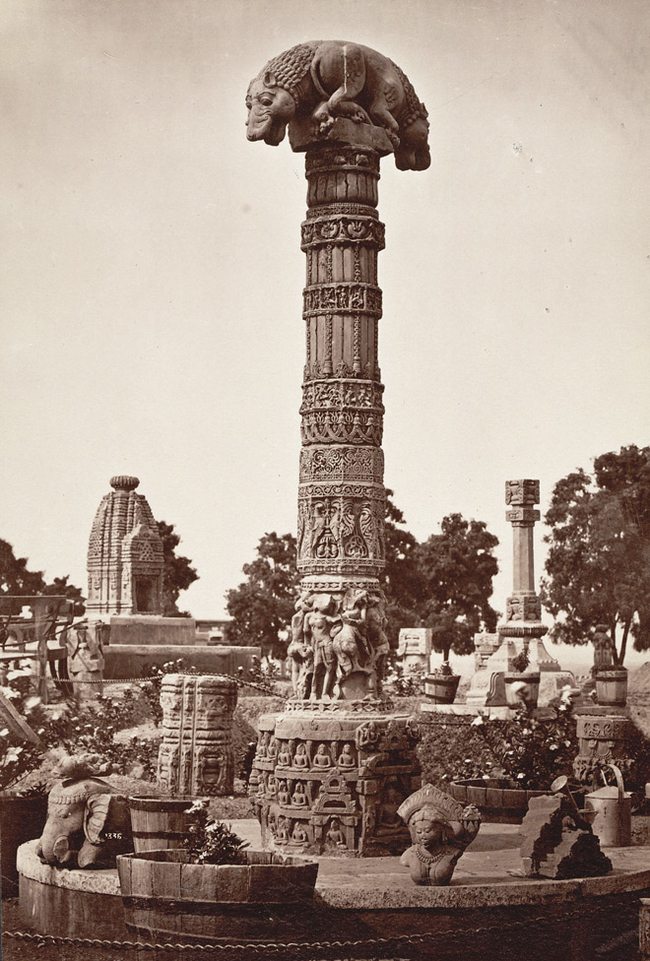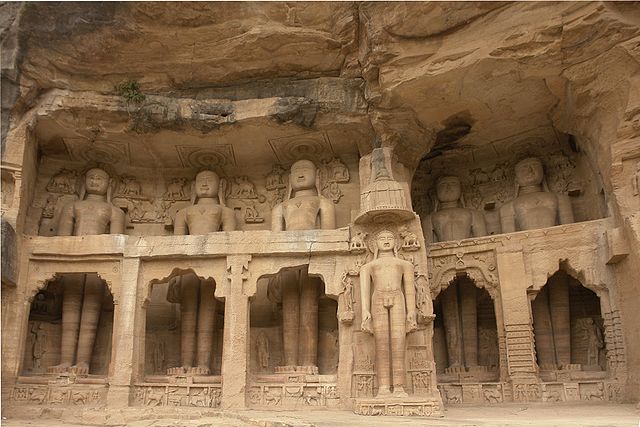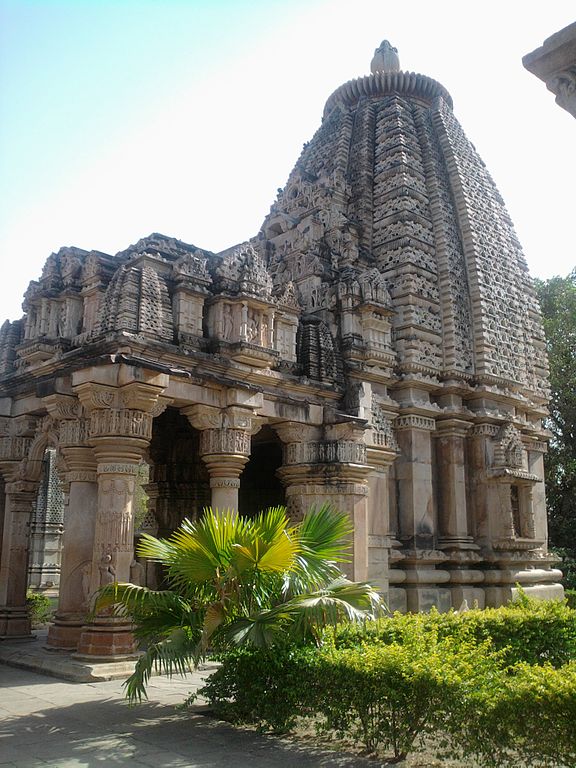
| GURJAR - PRATIHAR DYNASTY
Extent of the Pratihar Empire shown in green •
Capital : Kannauj
Gurjar-Pratihar dynasty :
Gurjar-Pratihar Dynasty (650-1036 CE) :
1.Dadda
I-II-III (650 - 750)
The Gurjar-Pratihar dynasty was an imperial power during the Late Classical period on the Indian subcontinent, that ruled much of Northern India from the mid-8th to the 11th century. They ruled first at Ujjain and later at Kannauj.
The Gurjar-Pratihars were instrumental in containing Arab armies moving east of the Indus River. Nagabhata I defeated the Arab army under Junaid and Tamin during the Caliphate campaigns in India. Under Nagabhata II, the Gurjar-Pratihars became the most powerful dynasty in northern India. He was succeeded by his son Rambhadra, who ruled briefly before being succeeded by his son, Mihir Bhoj. Under Bhoj and his successor Mahendrapal I, the Pratihar Empire reached its peak of prosperity and power. By the time of Mahendrapal, the extent of its territory rivalled that of the Gupta Empire stretching from the border of Sindh in the west to Bengal in the east and from the Himalayas in the north to areas past the Narmada in the south. The expansion triggered a tripartite power struggle with the Rashtrakut and Pal empires for control of the Indian Subcontinent. During this period, Imperial Pratihar took the title of Maharajadhiraj of Aryavart (Great King of Kings of India).
Gurjar-Pratihar are known for their sculptures, carved panels and open pavilion style temples. The greatest development of their style of temple building was at Khajuraho, now a UNESCO World Heritage Site.
The power of the Pratihars was weakened by dynastic strife. It was further diminished as a result of a great raid led by the Rashtrakut ruler Indra III who, in about 916, sacked Kannauj. Under a succession of rather obscure rulers, the Pratihars never regained their former influence. Their feudatories became more and more powerful, one by one throwing off their allegiance until, by the end of the 10th century, the Pratihars controlled little more than the Gangetic Doab. Their last important king, Rajyapal, was driven from Kannauj by Mahmud of Ghazni in 1018.
Etymology and origin :
Nilgund inscription (866) of Amoghvarsh mentions that his father Govinda III subjugated the Gurjars of Chitrakut The origin of the dynasty and the meaning of the term "Gurjar" in its name is a topic of debate among historians. The rulers of this dynasty used the self-designation "Pratihar" for their clan, and never referred to themselves as Gurjars. They claimed descent from the legendary hero Lakshman, who is said to have acted as a pratihar ("door-keeper") for his brother Ram. Some modern scholars theorize that a Pratihar ancestor served as a "minister of defense" (or Pratihar) in a Rasthrakut court, and that is how the dynasty came to be known as Pratihar.
Multiple inscriptions of their neighbouring dynasties describe the Pratihars as "Gurjar". The term "Gurjar-Pratihar" occurs only in the Rajor inscription of a feudatory ruler named Mathandev, who describes himself as a "Gurjar-Pratihar". According to one school of thought, Gurjar was the name of the territory (see Gurjar-desh) originally ruled by the Pratihars; gradually, the term came to denote the people of this territory. An opposing theory is that Gurjar was the name of the tribe to which the dynasty belonged, and Pratihar was a clan of this tribe.
Among
those who believe that the term Gurjar was originally a tribal designation,
there are disagreements over whether they were native Indians or
foreigners. The proponents of the foreign origin theory point out
that the Gurjar-Pratihars suddenly emerged as a political power
in north India around 6th century CE, shortly after the Hun invasion
of that region.
According to the Agnivansh legend given in the later manuscripts of Prithviraj Raso, the Pratihars and three other Rajput dynasties originated from a sacrificial fire-pit (agnikund) at Mount Abu. Some colonial-era historians interpreted this myth to suggest a foreign origin for these dynasties. According to this theory, the foreigners were admitted in the Hindu caste system after performing a fire ritual. However, this legend is not found in the earliest available copies of Prithviraj Raso. It is based on a Paramar legend; the 16th century Rajput bards claim heroic descent of clans in order to foster Rajput unity against the Mughals.
History
:
Early rulers :
Nagabhat I (730–756) extended his control east and south from Mandor, conquering Malwa as far as Gwalior and the port of Bharuch in Gujarat. He established his capital at Avanti in Malwa, and checked the expansion of the Arabs, who had established themselves in Sind. In this battle (738 CE) Nagabhat led a confederacy of Gurjar-Pratihars to defeat the Muslim Arabs who had till then been pressing on victorious through West Asia and Iran. Nagabhat I was followed by two weak successors, who were in turn succeeded by Vatsraja (775–805).
Varah (the boar-headed Vishnu avatar), on a Gurjar-Pratihar coin. 850–900 CE. British Museum. Resistance
to the Caliphate :
The Arab chronicler Sulaiman describes the army of the Pratihars as it stood in 851 CE, "The ruler of Gurjars maintains numerous forces and no other Indian prince has so fine a cavalry. He is unfriendly to the Arabs, still he acknowledges that the king of the Arabs is the greatest of rulers. Among the princes of India there is no greater foe of the Islamic faith than he. He has got riches, and his camels and horses are numerous."
Conquest of Kannauj and further expansion :
Gurjar-Pratihar
coinage of Mihir Bhoj, King of Kanauj. Obv: Boar, incarnation of
Vishnu, and solar symbol. Rev: Traces of Sasanian type. Legend:
Srímad Adi Varaha "The fortunate primaeval boar".
Around 786, the Rashtrakut ruler Dhruv (c. 780–793) crossed the Narmada River into Malwa, and from there tried to capture Kannauj. Vatsraj was defeated by the Dhruv Dharavarsh of the Rashtrakut dynasty around 800. Vatsraj was succeeded by Nagabhat II (805–833), who was initially defeated by the Rashtrakut ruler Govinda III (793–814), but later recovered Malwa from the Rashtrakuts, conquered Kannauj and the Indo-Gangetic Plain as far as Bihar from the Pals, and again checked the Muslims in the west. He rebuilt the great Shiv temple at Somnath in Gujarat, which had been demolished in an Arab raid from Sindh. Kannauj became the center of the Gurjar-Pratihar state, which covered much of northern India during the peak of their power, c. 836–910. [citation needed]
Rambhadra (833-c. 836) briefly succeeded Nagbhat II. Mihir Bhoj (c. 836–886) expanded the Pratihar dominions west to the border of Sind, east to Bengal, and south to the Narmada. His son, Mahenderpal I (890–910), expanded further eastwards in Magadha, Bengal, and Assam. [citation needed]
Decline
:
Mahmud of Ghazni captured Kannauj in 1018, and the Pratihar ruler Rajapal fled. He was subsequently captured and killed by the Chandel ruler Vidyadhar. The Chandel ruler then placed Rajapal's son Trilochanpal on the throne as a proxy. Jasapal, the last Gurjar-Pratihar ruler of Kannauj, died in 1036. [citation needed]
Gurjar-Pratihar art :
One of the four entrances of the Teli ka Mandir. This Hindu temple was built by the Pratihar emperor Mihir Bhoj.
Sculptures near Teli ka Mandir, Gwalior Fort.
Jainism-related cave monuments and statues carved into the rock face inside Siddhachal Caves, Gwalior Fort.
Ghateshwara Mahadeva temple at Baroli Temples complex. The complex of eight temples, built by the Gurjar-Pratihars, is situated within a walled enclosure. There are notable examples of architecture from the Gurjar-Pratihar era, including sculptures and carved panels. Their temples, constructed in an open pavilion style. One of the most notable Gurjar-Pratihar style of architecture was Khajuraho, built by their vassals, the Chandelas of Bundelkhand.
Maru-Gurjar
architecture :
Bateshwar
Hindu temples complex :
Baroli
temples complex :
Legacy
:
Source :
https://en.wikipedia.org/wiki/ |
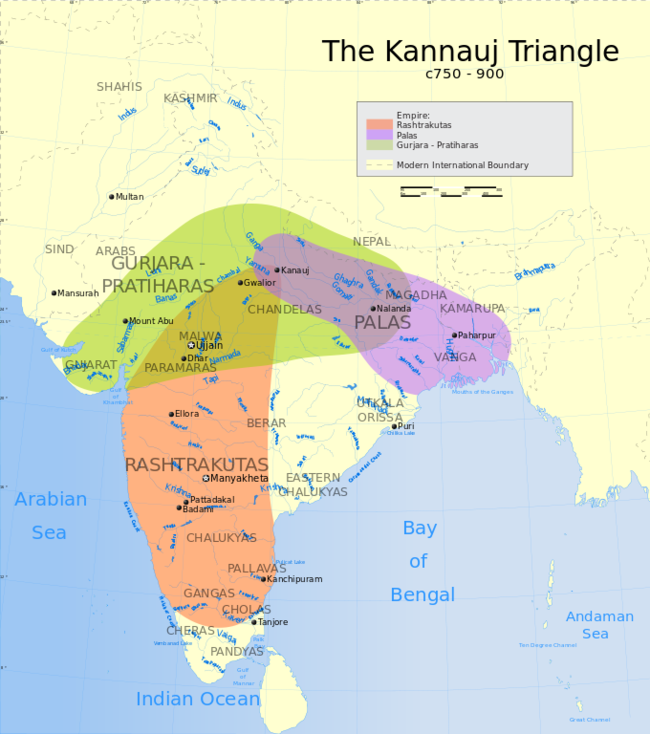
_from_Nilgund_of_Rashtrakuta_King_Amoghavarsha_I.jpg)
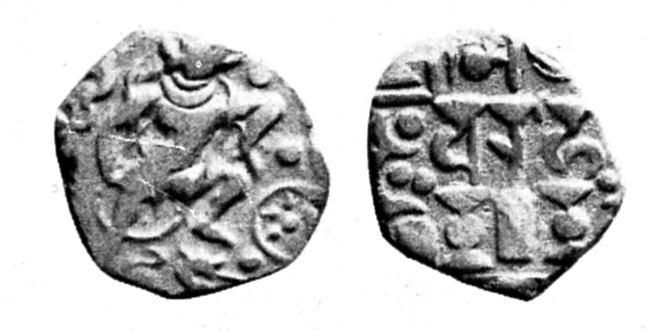
.jpg)
